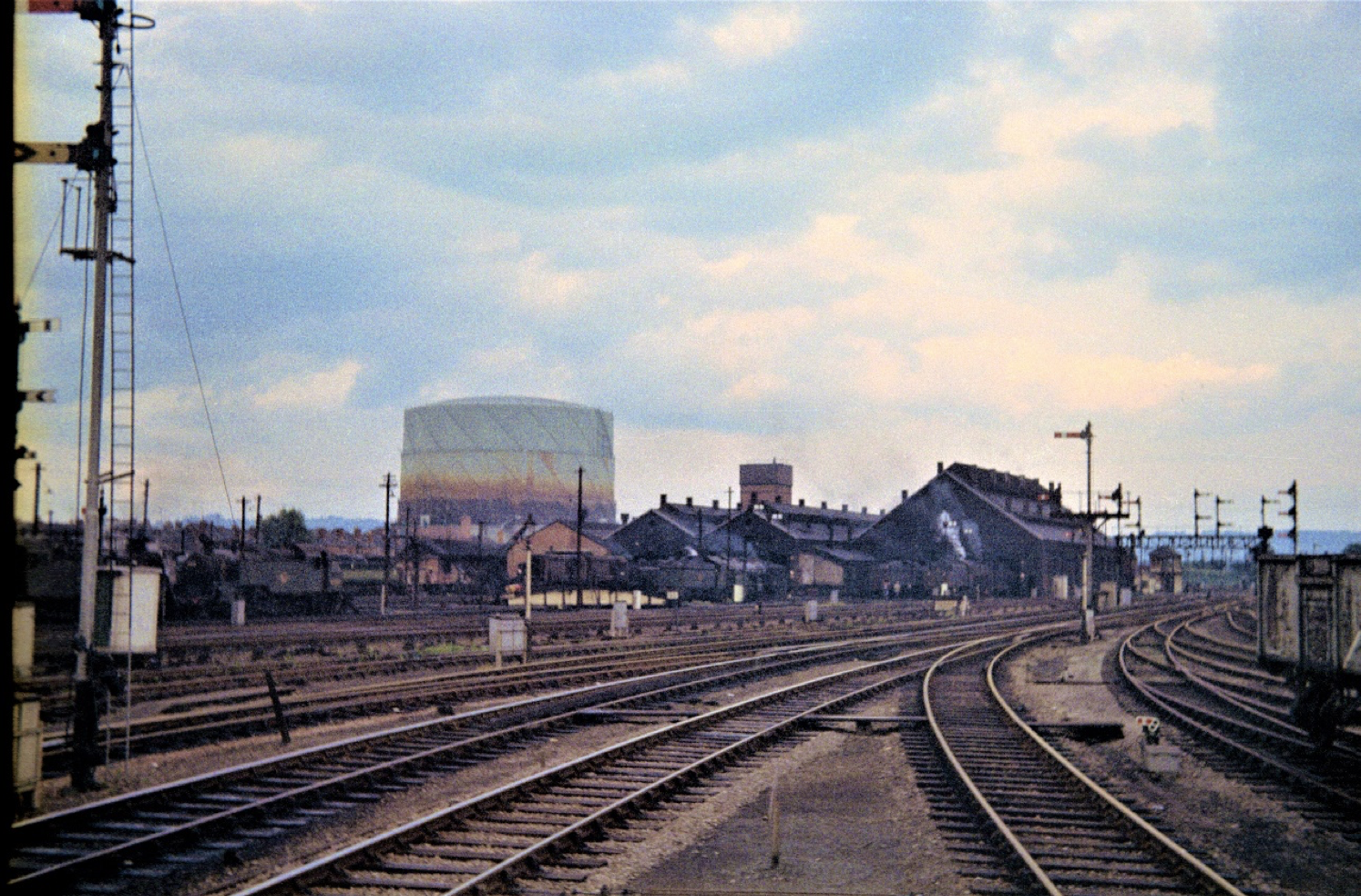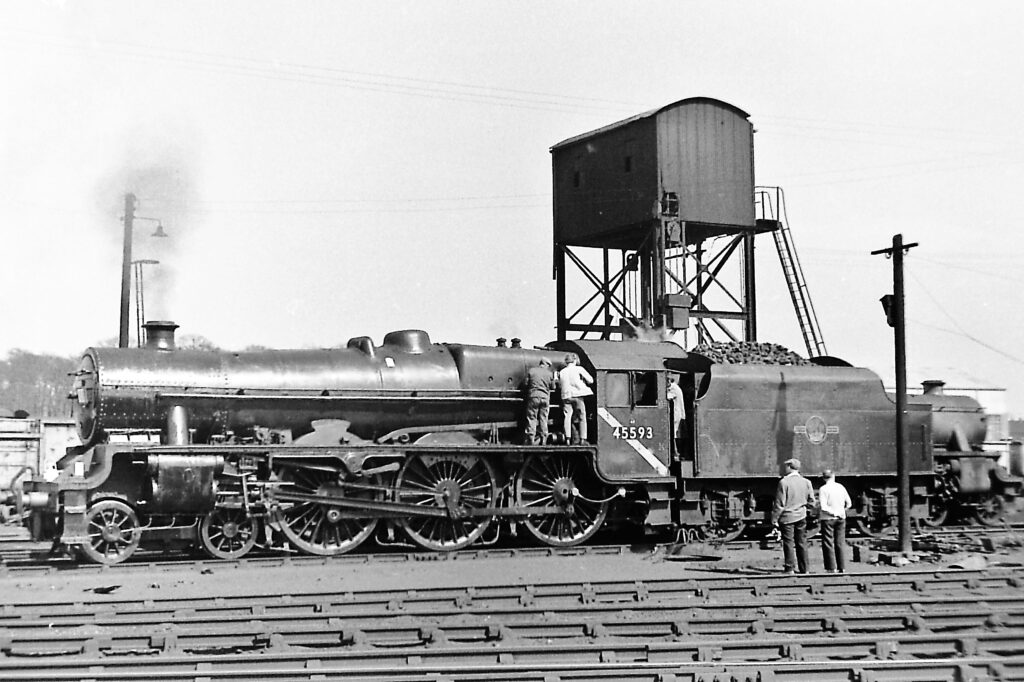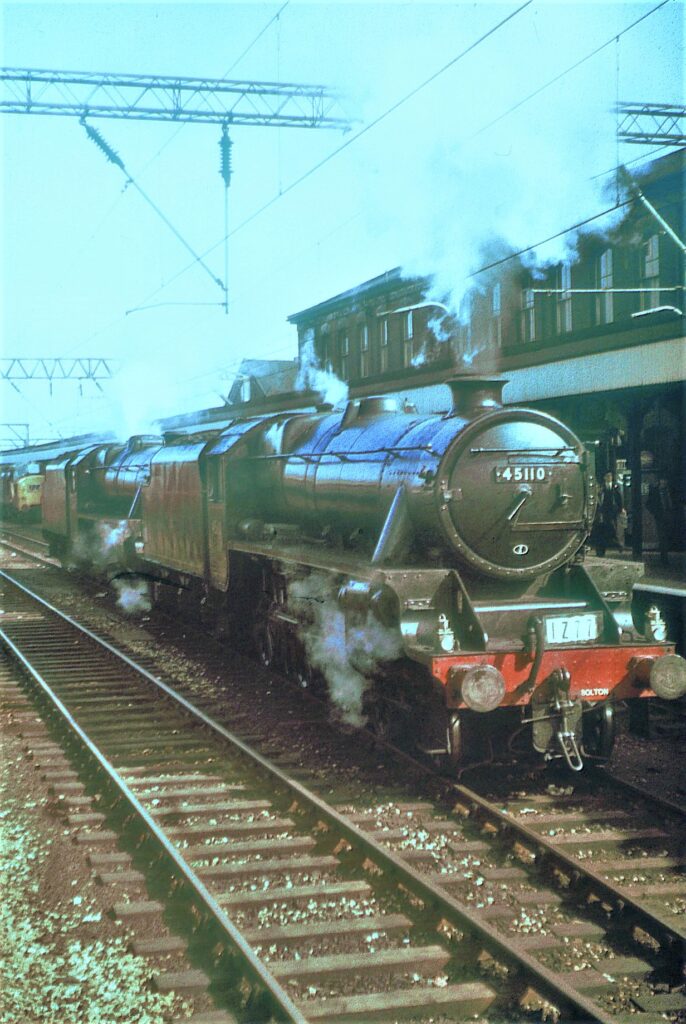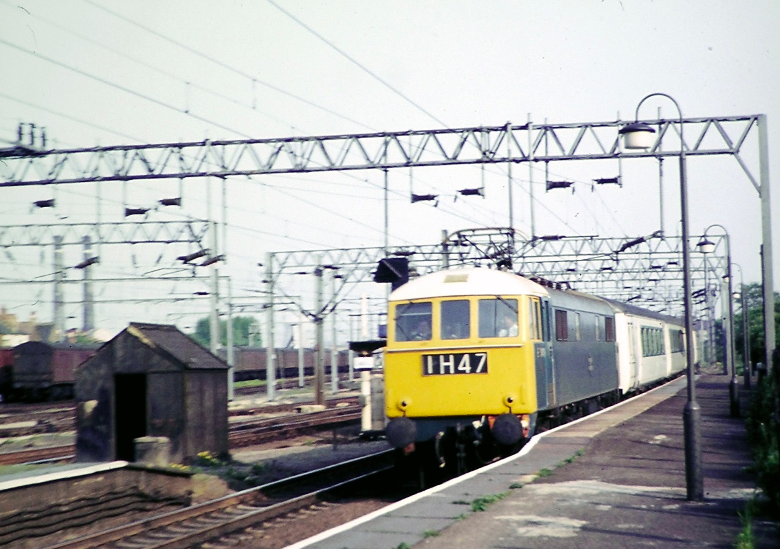Working for British Rail
I had resigned from DOS Tolworth in late 1965 and applied for a management job at W H Smiths in Kingston-on-Thames. As I was not really fitted for this work, being rather introverted, not surprisingly they did not wish to employ me. However, I found a temporary counter sales job in Kingston working at Bentall’s department store in the toy fair. After Christmas, I continued working as a clerk in their dispatch department whilst I was deciding on a career change. I then saw a job advertisement for cartographical draughtsman on BR which post I was duly offered after interview.
BR Estate Surveyors Department, Alperton
By Spring 1966 I was working for British Railways LM Region Estate Surveyor’s Department at Middlesex House, Alperton as a junior technical officer updating and renewing land-plans. The head of the Department was Roger Burbidge, a small ex-army man with a moustache who in hindsight reminded me of Capt. Mannering in ‘Dad’s Army’. My immediate boss and mentor, Richard Heaton-Smith, was head of the land survey section. He lived in Berkhampsted and came by train to Wembley Central, catching the bus onward to Alperton. Dick would go to the local pub (the ‘Pleasure Boat’) by the side of the Grand Union Canal at lunch time for a few pints after he had eaten his sandwiches, often coming back relaxed, but he encouraged me in my work.
I found this a fascinating occupation as one of my main tasks was the production of new land plans, replacing old plans or consolidating others where overlapping pre-nationalisation railway companies had land interests. The work involved the transfer of information from original title deeds of land owned by the railway onto a 1/1250 OS base. Original title deeds were obtained from the dark and dusty deed room in the bowels of Euston station. Some of these were two hundred years old going back prior to the purchase of land by the railway. Railway land was colour-washed green, with the railway boundary defined by a carmine line. The new plan, normally in a long strip, was then folded into a book hinged concertina-style so that it was easy to inspect the required length without unrolling the whole plan.
I worked on several interesting projects. For example, the land plan for Preston referenced title deeds related to the purchase of land for the Lancaster Canal dating back to the eighteenth century, prior to its takeover by the Preston and Lancaster Railway. The Carlisle land plan was also fascinating as no less than seven pre-grouping companies had land in the vicinity of Citadel station (LNWR, MR, NER, FR, CR, NBR, and GSWR). Probably the most challenging was the production of a new land plan for the routes between Nottingham and Mansfield, in three volumes. It meant combining the land plans of the three companies (MR, GNR and GCR) that ran in parallel up the Leen Valley as far as Annesley serving many collieries in the Nottinghamshire coalfield. I also worked on new plans for the Crewe to Manchester route.
Another aspect of the work involved updating old land plans, many of which dated from LMS days, although we did inherit smaller GWR plans for the Shrewsbury to Aberystwyth route when the line was transferred to the LM Region. This was a period when much surplus railway land was being sold, and it was necessary to keep accurate records of disposals. Details of recent land sales were added to the plans, along with details of wayleaves and rights of way across railway land. This is where my cartographic skills proved useful.
Some of the original land plans produced for construction of the railway were still in use: they could be over 100 years old and were often at a scale of 2 chains to the inch (1/1584). This was because land surveying was done using a Gunter’s chain of 100 links, 22 yards in length: twenty of these would measure a quarter mile. It is also interesting to note that prior to the introduction of continuous welded rail, the track was formed from rails of 60 feet length, 22 of which would make a quarter mile. This fact was also useful for estimating the speed of the train in conjunction with a wristwatch with a second hand (the number of rail-joints counted in 41 seconds would give a good estimate of speed in mph).
I also went out occasionally on the track as surveyor’s chainman with Dave Morris, as for example on 23 May, when we surveyed the yards around Derby shed and carriage sidings, staying in a grotty bed & breakfast near the station. We also went out on the lineside at Cropredy, near Banbury on 11 July. Another of the surveyors was Tegryn Roberts – a quiet gentle man with a small moustache: he had suffered horribly in the far East during WWII. There was also a ‘rights of way’ team in our office led by Charles Drinkwater, a large ebullient man, who went holidaying by caravan.
I also became friendly with Roy De’Ath who worked in the dispatch office. He was a true Londoner, living in the White City, and was extremely knowledgeable about London Transport operations, informing me of the complexities of Central Bus operations, and indeed went to Chiswick Works after leaving the railway. I had also heard about Aldenham Works, and one evening managed to hike a lift off the staff bus thanks to a fellow lodger at my Chiswick address who worked at Aldenham. The bus, an RTL with a tarpaulined sheet over the platform to discourage ordinary passengers, was hammered by the driver! Roy also introduced to the London Omnibus Traction Society of which he was an early member, and we spent many days out riding around distant parts of London thanks to Red Rover tickets. He later worked for London Transport Underground as a storeman at Central Line depot at West Ruislip.
Initially I lived in Chiswick travelling to work by London Transport Underground from Chiswick Park, changing at Acton Town from a District Line to Piccadilly Line train for Alperton. I did not stay long at that address, and soon moved to Kentish Town, where a fellow employee, Dennis Delaney, was lodging at a GLC hostel in Holmes Road. This meant a commuting trip on the North London line catching a Broad Street – Watford Junction train via Primrose Hill, a service that only ran in peak hours. However, as I travelled against the peak-hour flow, trains were never packed, apart from the women joining the train at Queen’s Park who worked at the MacVities biscuit factory at Harlesden. The final stretch of the journey from Wembley Central down the Ealing Road to Alperton was by 79 or 83 bus.
Whilst at Alperton I applied for the BR graduate management training scheme, which gave the opportunity for railwaymen to experience the full range of operational activities before being placed in a management role. I passed the entrance exam with flying colours but, unfortunately, was rejected on medical grounds. I still wonder what sort of career I might have had, had I remained with British Rail. But I remain a railway enthusiast!
Northern rail-tours
Now that the variety of steam out of Waterloo was rapidly decreasing, I started to turn my attention northwards. As I was working for British Railways, I had the benefit of quarter-fare privilege tickets for my railway jaunts, so on 30 April 1966 I took my first steam rail-tour of the year. The South Yorkshireman no. 5 Railtour, organised by the Jubilee Railway Society, left Bradford at 8.25am hauled by ‘Jubilee’ No.45593 Kolhapur. We visited sheds at Skipton and Carnforth and continued to Carlisle over Shap where we visited the two Carlisle MPDs, before returning over the threatened Settle & Carlisle route behind ‘Britannia’ Pacific No. 70035 Rudyard Kipling. I went up to Bradford overnight, and spent the next evening in the Midland Hotel, next to Forster Square station before returning via Mirfield and Huddersfield.
On the 25 June I travelled up to Scotland from St Pancras via the Settle & Carlisle line, and Waverley route to Edinburgh and later Glasgow. My main aim was to get a final ride behind an ‘A4’ before they were retired. I caught the 8.25am from Buchanan Street to Aberdeen, hauled by No. 60019 Bittern. On arrival, No. 60034 Lord Faringdon was waiting to be photographed at the head of the 1.30pm express to Glasgow. My Scottish trips are described in more detail in Freedom Of Scotland.
‘Jubilee’ 4-6-0 No. 45593 Kolaphur receives attention whilst laying over at Carlisle Kingmoor MPD during the South Yorkshireman rail tour on 30 April 1966.
On the 23 July I took another trip to the West Riding, as the local trains between Bradford and Leeds were still steam worked by Fairburn 2-6-4Ts. I caught the 8.38am from Marylebone to Nottingham, taking a last trip on the Great Central, and on via Barnsley and Wakefield to Leeds. I returned via the Calder Valley to Manchester, again thanks to my privilege tickets, before returning to Euston on 24 July. Unfortunately, I have no photographs of this trip. I travelled again to the West Riding on 22 October to Bradford Exchange, where the 2-6-4Ts were in their final months of passenger train working. I then moved on via Carlisle to Edinburgh. I spent Saturday evening in Dundee, and remember being unable to find anywhere to eat, not even a Chinese restaurant.
Finally, on 19 November I travelled up overnight on the 1.15am sleeper from Kings Cross to Newcastle to see ‘9Fs’ working the iron ore trains from Tyne Dock via South Pelaw to the steel works at Consett. This was the last day of steam operation before steam was replaced by pairs of Sulzer ‘Type 2s’, being rerouted via Gateshead and the main line. I particularly remember riding about, half-asleep, on Northern General buses to get to Annfield Plain, to photograph the operations. Unfortunately, my photographs of ‘9F’ 2-10-0 No. 92063, decked out in ‘farewell’ style were not good, due in part to my weariness.
1967: in search of last BR steam
In March 1967 I joined two Stephenson Locomotive Society railtours with Roger Peakman, staying overnight with his parents in Dads Lane, Kings Heath, Birmingham. In autumn 1966 he had joined the Estate Surveyor’s Department previously having worked in a bank. His parents were a lovely rather old-fashioned couple who kept a Morris 1100 in their front garden under a tarpaulin. His father had worked at IMI Witton, and his mother was a true Black Country girl. She made a splendid traditional Sunday roast chicken too, complete with bread sauce. Roger was attached to a Baptist church and was interested in geology but was not a fan of Darwin! Canal history was his earlier interest, especially those of the West Midlands. One of his acquaintances was W A (Bill) Camwell who was an acknowledged expert on all things related to industrial archaeology in the West Midlands.
Roger also acquired a portable battery tape recorder, which he used to record the last steam trains in action. I had accompanied him on several trips, particularly recording Bulleid Pacifics in action on the line of out Waterloo. Roger also had a complete collection of one-inch OS maps (which I inherited) and had built up a library of his own 8 mm cinefilms covering the extensive railway network of the South Wales valleys. In this sense he reminded me very much of John Spencer-Gilks, who had also aimed to record every branch line on the network.
On Saturday 4 March we travelled the Peak District by DMU from Derby to Buxton and Chinley, to mark the ending of through trains from Manchester to St Pancras, and the closure to passengers of the Matlock – Buxton section. Rowsley MPD was derelict, but Buxton had some Stanier ‘8Fs’ in steam. Whilst our DMU paused at Chinley, an empty Northwich – Peak Forest limestone train passed through in the hands of Sulzer ‘2’ No. D5275, having taken over from ‘8Fs’ in the year before.
On the following day we commemorated the end of through passenger trains between Birkenhead and Paddington aboard a rail-tour travelling the route from Birmingham to Birkenhead. We left Tyseley at 9.00am behind 7029 Clun Castle, via Wolverhampton Low Level, Shrewsbury and Chester, with a photo-stop at Wrexham. However, the ‘Castle’ was not performing well and lost over 30 minutes on the way to Chester. After arrival at Birkenhead Woodside, we ran to Chester and back behind ‘9F’ No. 92234, with a photo-stop at Hooton in the outbound direction. ‘9Fs’ were still in use at that time on Bidston – Shotwick iron ore trains (serving the John Summers steelworks at Shotton), but they were retired with the end of steam at Birkenhead from 6 November 1967, when a resplendent ‘9F’ No. 92203 worked the last ore train. 2-6-4T No. 42616 was on display at Woodside before our return at 2.15pm to Birmingham Snow Hill behind ‘Black 5’ No. 44680. The return trip included a photo-stop at Ruabon. By now the line was under LM control, so ex-GW motive power was scarce although the local steam shed, Croes Newydd (84J), retained a few pannier tanks. However, the shed closed three months later, on 4 June 1967.
With the demise of steam on the Southern Region in July 1967 I focussed my attention on the remaining areas of steam in the North-east and North-west. So, on 19 August I went up overnight to the north-east from St Pancras. Four ‘WD’ 2-8-0s and a ‘B1’ were awaiting cutting-up at Rotherham. I paid visits to Hartlepool (which still had a couple of ‘Q6s’, Nos. 63407/31 on its books), Sunderland (where I saw No. 63421), and Blyth, where ‘J27’ No. 65885 was present in the company of six Ivatt ‘4’ 2-6-0s. I also photographed No. 4498 Sir Nigel Gresley in LNER garter blue livery working a special train to Edinburgh through Alnmouth on the Northumberland coast.
With the end of steam in Yorkshire in November fast approaching, I turned again to the North-west for steam action. On 28 October I caught a special organised by the Severn Valley Railway Society and Manchester Rail Travel Society. Leaving Birmingham at 9.25am we travelled to Stockport under electric traction, before switching to steam traction for the short run behind ‘Black 5’ No. 45411 to Manchester Victoria. Then ‘Britannia’ Pacific No. 70013 Oliver Cromwell came on to take us on via the Calder Valley, Huddersfield, Penistone, Sheffield Victoria, and Doncaster for a photo-stop before changing engines at Normanton. Here ‘Jubilee’ No. 45562 Alberta took over for the climb up to Halifax, returning to Normanton via Low Moor and Ardsley. No. 70013 took over again for the run avoiding Leeds City via Skipton to Rose Grove where Standard ‘5’ No. 73040 took over for the final run back to Stockport via Blackburn and return to Birmingham with an electric loco. By this time only four ‘Jubilees’ were in active service – all at Holbeck – and No. 70013 was destined to be one of the last surviving locomotives and was the last one to be overhauled at Crewe. As an embargo was being placed on steam specials from the start of 1968, this would be one of the last specials of this kind. I stayed in Manchester overnight at a hotel near Victoria station and paid a visit to Blackpool on the Sunday before returning south.
A month later, on 25 November I took my final steam rail-tour, again with the Manchester Rail Travel Society, behind ‘A4’ No. 60019 Bittern on a round tour from Leeds leaving at 10.20am. Steam in Yorkshire had officially ended on 1 October, when Low Moor and Holbeck were closed to steam. Royston followed suit on 5 November, leaving only Normanton to service locos reaching the area from Manchester and Carlisle.
The route was via Carnforth, Wigan, Patricroft, Guide Bridge, Manchester Victoria, Bolton, Rochdale, Mirfield, Dewsbury and back to Leeds. I timed the train between Lancaster and Wigan. I returned to London on the Sunday, recording two Standard ‘3’ 2-6-0s, Nos. 77002/12 in the scrapyard of Garnham, Harris & Elton at Sheepbridge, Chesterfield.
France
1967 was also the year in which I travelled abroad for the first time in search of the steam we could no longer find at home, aided by the availability of privilege tickets on the railway. From 27 to 30 May I went on my first trip to France, being inspired by reading “Railway Holiday in France’’. I flew to Paris, and travelling to Clermont-Ferrand via Montluçon, staying overnight in Brioude before crossing the Cevennes in a scenic railcar to Nimes. The aim was to photograph and ride behind the 241Ps which worked the expresses between Moret-les-Sablons and Clermont-Ferrand. In less than two months I was back in France for the weekend travelling between Calais and Paris behind the 231Ks and 141Rs and photographing the 141TCs working suburban push-pull trains out of Paris Nord.
1968: the end of BR Steam
London Midland sheds at Crewe South and Birkenhead were closed from 5 November 1967, the closure of Birkenhead ending the reign of the ‘9Fs’ on Birkenhead Docks – Shotwick sidings ore trains. On the 4 December, Warrington Dallam (8B) and Springs Branch (8F) were also closed to steam, thus removing regular steam-hauled turns from the WCML south of Preston.
My last trip of the year was alone to Cumbria, and on a very cold 31 December managed to get round Workington shed. The depots at Kingmoor, Workington and Tebay closed to steam from 1 January 1968, and with their closure the wholesale withdrawal of ‘Britannias’ and ‘9Fs’ ensued. Tebay shed had provided bankers for the Shap incline, which had been worked by Fowler, and later Stanier 2-6-4Ts, although replaced by Standard ‘4’ 4-6-0s in 1967 for the last year. Steam was thereafter restricted to working south of Carnforth.
During 1968, along with countless other enthusiasts, my attention turned to North-west England making several trips to photograph steam during their last months. Lancashire had become the last stronghold of steam, and I paid several visits to loco sheds to photograph in colour slides the last of steam, including Rose Grove, Lostock Hall, Bolton, Patricroft, and Newton Heath. Motive power was restricted now to LM ‘Black 5s’ and ‘8Fs’, plus Standard classes (mainly 4-6-0s, and ‘9Fs’). I also joined the Railway Correspondence & Travel Society that year and so took copies of their magazine, The Railway Observer, for three years. Its main benefit was to track the movements and disposal of the last steam locomotives, and the fates of early diesel locomotives which were already heading for the scrapheap.
At the end of January, I took photographs at Newton Heath (9D), Heaton Mersey (9F) and Patricroft (9H). The first shed closures of 1968 occurred on 4 March, when Northwich (8E), Trafford Park (9E) and Buxton (9L) were closed, and steam removed from the lines of the CLC and its constituents. The main duties in this period were the shipment of limestone from the quarries around Buxton, notably Tunstead, to the ICI Mond chemical plants in the area around Northwich (which used local salt and anhydrite, transported from the mine served by Long Meg sidings on the Settle & Carlisle route). I managed to photograph these workings in February. On 6 and 7 April, I took more photographs at Stockport (9B), 9D, 9F, 9H and Bolton (9K).
On 20 April I boarded my last steam trip, a joint MRTS / SVRS North West Tour from Birmingham. Hauled by E3180 as far as Stockport, two ‘Black 5s’ Nos. 44949 and 45110 took the train on to Buxton, Chinley and Stalybridge, where they were relieved by ‘Standard 5s’ Nos. 73069 and 73134. We then proceeded through Standedge tunnel to Huddersfield, switching to the L&Y Calder Valley route through Hebden Bridge, and over Copy Pit to Rose Grove. We continued to Bolton but had to run ‘wrong line’ through Sough tunnel due to engineering works. At Bolton ‘8F’ No. 48773 took over for the run to Stockport via Bury, Oldham, Dean Lane Newton Heath, and Droylsden. The final section by steam was entrusted to ‘9F’ No. 92160 to Liverpool Lime Street via Northenden and Warrington Bank Quay LL. Here E3093 took over to return us to Birmingham.
On 20 April 1968 at Stockport Edgeley, ‘Black 5s’ Nos. 45110 and 44949 prepare to back onto 1Z77, the MRTS/SVRS North West Tour, bound for Disley and Buxton.
Other sheds in the Liverpool area (8A and 8C) were closed on 4 May, and the penultimate closures took place on 1 July, when sheds in the Manchester area were closed (9D, 9H, 9K) leaving only those at Lostock Hall (10D), Rose Grove (10F) and Carnforth (10A) as steam sheds. On 4 August I made my final trip with Roger Peakman to Carnforth division sheds with my camera, taking colour slides at the final three steam sheds, 10A, 10D and 10F, all of which were closed the following day. The final specials, which I did not see, ran a week later, on 11 August: ended thus the reign of standard gauge steam on British Railways.
Electrics come to Euston
The AC electrification of the WCML commenced with a pilot project using the Manchester to Crewe line. The first electric loco No. E3001 was delivered in November 1959 along with a batch of ‘AM4’ EMUs. This was the start of a major scheme involving a second phase to Liverpool and then working southwards from Crewe towards London in stages. Not long after I joined British Railways, the electrification of the WCML from Euston was completed. Electric services between Euston and Manchester commenced in 1966, using new ‘AL6’ locos in blue livery with Mark II coach-sets also in the new blue and white livery. In addition, an electric Pullman service was inaugurated, replacing the LMR Diesel Pullman sets which had previously operated out of St Pancras passed to the Western Region.
A full AC electric service out of Euston commenced on 1 January 1967, and an accelerated timetable was introduced on 18 April to capitalise on the improved performance of ‘AM10’ emus and ‘AL6’ type electric locomotives. Whilst at Alperton I took some action shots of electric expresses in the vicinity of Wembley but did not record details or dates. One thing I do remember though was the phenomenal speed of most trains: northbound trains from Euston regularly rushed through Wembley at 100 mph.



